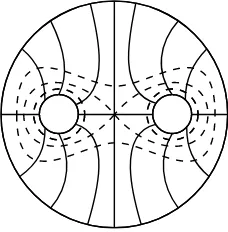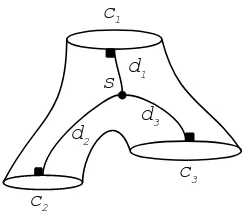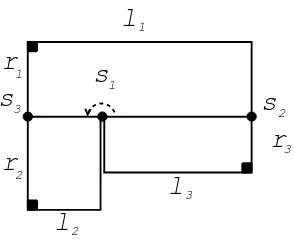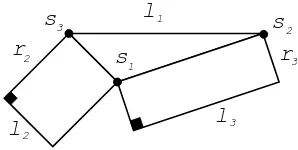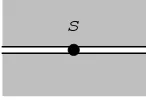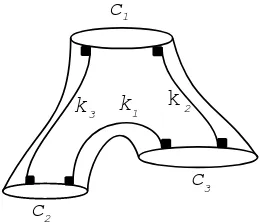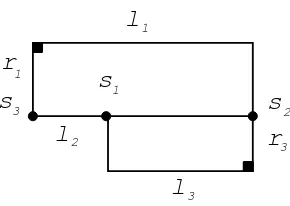flat structures on surfaces
Ousama Malouf
Dedicated to the 70-th anniversary of Professor Constantin Udriste
Abstract.We study in this work flat surfaces with conical singularities, that is, surfaces provided with a flat structure with conical singular points. Finding good parameters for these surfaces in the general case is an open question. We give an answer to this question in the case of flat structures on pairs of pants with one singular point. The question of decomposability of an arbitrary flat surface into flat pairs of pants is discussed.
M.S.C. 2000: 57M50, 32G15.
Key words: Flat structure; Teichm¨uller space; conical singularity.
1
Introduction
In this article, we consider flat surfaces with a finite number of conical singularities, that is, surfaces provided with a flat structure with conical singular points. A conical singular point has a total angle different from 2π.
Finding good parameters for these surfaces is still an open question (one should mention here that there are well-known good parameters for the subset of flat surfaces defined by quadratic differentials on Riemann surfaces). We treat here the question of classifying flat pairs of pants with one singularity. The decomposition of surfaces into pairs of pants is a common practice to study various structures on surfaces (see for instance [6]). The idea, which is usually attributed to Grothendieck, and which is developed by Feng Luo in [6], is to provide building blocks (generators) which permit to reconstruct any surface endowed with the studied structure following some specific rules (relations). It should be noted however that there exist flat surfaces which are not decomposable into flat pairs of pants by disjoint simple closed geodesics (for an example of flat surface of genus 3 with one singularity, see Example 5.1). But, it is possible to decompose such a surface into pairs of pants if we sacrifice some rules of decomposition, such as the simplicity of geodesics in the decomposition.
In Section 2, we give a definition of flat surface, we recall the formula of Gauss-Bonnet and we give some examples. In Section 3, we classify flat pairs of pants with one singularity and we study their space of parameters. In Section 4, we present the
∗
Balkan Journal of Geometry and Its Applications, Vol.15, No.1, 2010, pp. 90-103. c
In Section 5, we discuss the decomposability of a surface into pairs of pants.
This work uses ideas from [3, 2] in which the authors consider the similar question for hyperbolic surfaces with singular points.
2
Preliminaries
Definition 2.1. Let Mg,k (denoted by M if there is no confusion) be a surface of genusgwithkboundary components, provided with a flat metricd(., .) with finitely many conical singularitiesΣ={s1, . . . , sn}. We assume all the boundary components ofM are closed curves (homeomorphic to circles). We denote by ∂M the boundary ofM and by Int(M) =M\∂M the interior ofM. More precisely:
• For each pointx∈Int(M)\Σthere is a neighborhoodU(x) isometric to a disc in the Euclidean plane.
• For each points∈Σ∩Int(M) there is a neighborhood isometric to a Euclidean cone of total angle 0< θ <+∞, withθ6= 2π.
• For each point x ∈ ∂M\Σ there is a neighborhood isometric to a Euclidean sector with angle measureπ at the image ofx.
• For each points∈Σ∩∂(M) there is a neighborhood isometric to a Euclidean sector of angle 0< θ <+∞, withθ6=π.
The metricd(., .) will be called aflat structureonM, andM will be called aflat surface(with boundaryif it exists).
Definition 2.2. The curvature κat a conical singularity s of total angle θ is κ = 2π−θ. The curvature at a singular point on the boundary of angleθ isκ=π−θ.
This definition of curvature is motivated by the following formula:
Proposition 2.3 (Gauss-Bonnet formula for closed surfaces [5, p. 113], [1, p. 190] or [7, p. 85-86] for a proof ). Let M be a closed flat surface of genus g
withnconical singularities. Letθi, i= 1, . . . , nbe the total angles at the singularities.
The formula of Gauss-Bonnet which connects the number of singularities with their total angles and the genus is:
(2.1)
n X
i=1
(2π−θi) = (4−4g)π
The Euler characteristic of this surface is given byχ(M) = 2−2g, and the formula of Gauss-Bonnet in terms of the Euler characteristic is:
n X
i=1
Corollary 2.4 (Gauss-Bonnet formula for a disc with b holes). Let M be a flat surface of genus 0 with boundary, with n singularities in the interior and m
singularities on the boundary, and letb be the number of boundary components. Let
θi, i = 1, . . . , n be the total angles of conical singularities in the interior, and let
τj, j = 1, . . . , m be the total angles of singularities on the boundary. Then,
(2.2)
n X
i=1
(2π−θi) + m X
j=1
(π−τj) = (4−2b)π .
Proof. By taking the double ofM (in this operation, each singularity on the boundary is glued to its copy) we obtain a closed flat surface of genusg =b−1 with 2n+m
singularities. By the formula of Gauss-Bonnet (2.1) we get the result. ¤
More generally, the Euler characteristic of a surfaceM of genusgwithbboundary components is given byχ(M) = 2−2g−b, and the formula of Gauss-Bonnet in terms of the Euler characteristic is:
n X
i=1
(2π−θi) + m X
j=1
(π−τj) = 2πχ(M).
Example 2.5. LetM be a pair of pants (a surface homeomorphic to a disc with two holes), equipped with a flat structure with one conical singularitysin its interior and such that each component of the boundary∂M = c1∪c2∪c3 is geodesic without
singularities.
From swe take three geodesic segmentsdi, i= 1,2,3 which realize the distances between s and ci respectively, Figure 3. We denote by li, ri the lengths of ci, di respectively. We cut and openM along the geodesic segments di. Then we obtain a connected surfaceP which can be decomposed into three rectangles Ri, i= 1,2,3 whose lengths of sides areli, rirespectively, and one triangle whose sides have lengths
li, as shown in Figure 4.
Following the inverse procedure, we consider a triangleT of side lengths li, and three rectangles Ri each of which shares a side with T and the other side being of lengthri as shown in Figure 4.
Now, by identifying the sides of equal lengthri, we obtain a flat pair of pants with one conical singularity. Note that the total angle of the singularity isθ= 4π.
This example will be studied later in Section 3.
Example 2.6. We cannot build a flat pair of pants with no singularities at all. Indeed, if we assume that such a pair of pants exists, by the formula (2.2) we find 0 =−2πwhich is impossible.
Figure 1: The two transverse measured foliations on the pair of pants induce a flat structure with one singular point
3
The geometry of a flat pair of pants with a conical
singularity
In this section we assume thatM is a flat (singular) surface with boundary homeo-morphic to a disc with two holes. We assume further that M has only one conical singularitys. We call such a surface aflat pair of pants with one singularity (or just
flat pair of pants). An example of such structure is obtained by taking the metric as-sociated to two transverse measured foliations with one singularity onM (see Figure 1). It is clear from this picture that the parameter space for the transverse measures of these two transverse foliations has dimension four, and it produces a space of flat structures of dimension four on the pair of pants, with one singular point. It will follow from the discussion below (see the remark after Definition 4.1) that there are examples of flat structures onM which do not arise from pairs of transverse measured foliations. The aim of this section is to find a set of real parameters which determine the geometry ofM.
The first natural guess is that the lengths of boundary geodesics might be good parameters, in analogy with the case of hyperbolic pairs of pants (described for in-stance in [4]). This is easily seen to be false, as one can glue Euclidean cylinders to boundaries of flat pairs of pants, changing the isometry type, without changing the boundary component length (see Figure 2). Thus, the parameter space for flat struc-tures on pair of pants is more complicated than the parameter space for hyperbolic structure on such surfaces.
Let ∂M = c1∪c2∪c3 denote the boundary and denote by d(., .) the distance
function on M. Let di be a geodesic segment which realizes the distance d(s, ci) between the singularitys and the boundary componentci. This segment intersects the boundary component with a right angle. We denote byli the length ofci and by
ri the length ofdi. Obviously, the parameters ri, i= 1,2,3 depend on the position ofs. We have the following proposition.
Proposition 3.1. The real parametersli, ri, i= 1,2,3 determine a unique flat pair
of pantsM with one singularity up to isometry, where the li are the lengths of the
boundary componentsci, and the ri are the lengths of the geodesic segments between
Figure 2: We can change the isometry type of a flat pair of pants without changing the boundary curve lengths
c
c
2
1
3
c
d
d
d
1
2
3
s
Figure 3: Flat pair of pants with one singularity in the interior
Proof. Every boundary componentci, i∈ {1,2,3}is geodesic, even if the singularity is on a boundary component, since by the formula of Gauss-Bonnet, the angle ats
will be 3π. By our assumption on the uniqueness of the singularity,di does not meet another singularity on the componentciof the boundary, and so, sinceci is geodesic,
di is orthogonal to ci. For the same reasons, di does not share any of its interior points with boundary components.
First case: We assume thats∈Int(M). This implies that the lengths ofdi are different from zero,ri 6= 0, i= 1,2,3. We cutM along d1∪d2∪d3, see Figure 3, to
obtain a polygonal flat surfaceP homeomorphic to a disc without singularities in the interior, see Figure 4.
None of the parametersli, i= 1,2,3 can be zero, because if one of them is zero, the surfaceM looses one of its boundary components. This fact implies that we always have three copies of safter the cut. Let us denote by si, i = 1,2,3 the copy which lies betweend(i+1) mod 3andd(i+2) mod 3, Figure 4. We can draw inP the geodesics
between these copies. These geodesic segments bound a triangleT = (s1s2s3) , Figure
5, which can be degenerate, with none of its angles greater thanπ. For instance, in Figure 6 the angle∡(s2s1s3) =π. This angle cannot be greater thanπ, because this
implies that d1, along which the cut was made, was not a geodesic segment which
represents the distance betweensandc1. This contradicts the assumption.
[image:5.595.246.369.280.388.2]l
1s
s
s
l
3l
21
2 3
r
1
r
2
[image:6.595.232.381.141.253.2]r
3Figure 4: After cut. li, ri are the lengths ofci, di respectively
c
c
2
1
3
c
[image:6.595.239.374.325.445.2]s
Figure 5: Here we see the triangle on the pair of pants
l
1s
s
s
l
3l
2 12 3
r
1r
2r
3 [image:6.595.235.382.520.643.2]c
c
2
1
3
c
d
d
2 3
[image:7.595.242.372.125.237.2]s
Figure 7: Singularity on the boundary
composed ofT andRi, i= 1,2,3.
A rectangle is uniquely determined up to isometry by its length and height, and a triangle is uniquely determined up to isometry by its lengths of sides. Then, given the parameters li, ri, i = 1,2,3, where the li, i = 1,2,3 satisfy the triangle inequalities, we can construct a unique pair of pants with one singularity by gluing together the three rectanglesRi and the triangleT given by the parametersli, ri, i= 1,2,3.
The triangle could be degenerate, and this case lies on the boundary of the space of triangles. This happens only when
(3.1) li=l(i+1) mod 3+l(i+2) mod 3
for somei∈ {1,2,3}. Figure 6.
Second case: We assume thats∈∂M. Then at least one of ri, i= 1,2,3 equals zero. More precisely,sbelongs to only oneci, i∈ {1,2,3}, and so only oneri equals zero, because ifsbelongs to more than one boundary component, it does not have a neighborhood homeomorphic to a disc. In such a case we call this adegenerate pair of pants. We will outline these cases later.
Without loss of generality, assumes∈c1, as in Figure 7. Cut alongd2∪d3 (d1
being reduced to s) to obtain a polygonal flat surface P homeomorphic to a disc without singularities in the interior. For the same reason as before, we have three copies ofs. The geodesic segment betweens2, s3isc1itself sincec1is geodesic.
The geodesic segments between the copies ofsbound a triangleT = (s1s2s3) which
can be degenerate, with none of its angles greater thanπ (for the same reason as in the first case). It is easy to recognize, in addition toT, two rectanglesRi, i = 2,3. Figure 8.
Knowing the parametersli, ri, i= 1,2,3 we can determine if the singularity is on the boundary and on which component. The rectangles Ri and the triangle T are uniquely determined by the parameters and so is the flat structure.
If Relation (3.1) is satisfied, the triangle is degenerate. In this case we notice that only oneri, i∈ {1,2,3}that correspond to the boundaries on the right hand side of this identity can take the value zero. The other cases are degenerate.
s
l
3l
21
2
r
[image:8.595.232.381.125.200.2]2
r
3Figure 8: The resulting heptagon after cut
We deduce that each flat pair of pantsM is uniquely determined, up to isometry, by the parametersli endri. And vice versa.
¤
Let us give the limits of parameters in view of the last proof. The length param-eters can take any values satisfying these conditions:
• 0< li<∞, i= 1,2,3,
• li≤l(i+1) mod 3+l(i+2) mod 3, i= 1,2,3, • 0≤ri<∞, i= 1,2,3,
• 0< ri+r(i+1) mod 3, i= 1,2,3
• Ifli=l(i+1) mod 3+l(i+2) mod 3,for some i∈ {1,2,3}then 0< ri<∞
Remark. LetM be a flat surface with one singularitys, which is homeomorphic to a disc withnholes,n≥3. We denote byci the boundary components ofM and bydi the geodesic segments fromstoci. If we setli the lengths ofci andrithe lengths of
di, then the parameters li, ri do not characterize M in the sense of Proposition 3.1. This follows because if we cutM alongd1∪d2∪ · · · ∪dn then instead of a triangle (s1s2s3) we get a (n+ 1)-gon which, of course, is not uniquely determined by the
lengths of its edges.
We return to the case whereM is a pair of pants and∂M =c1∪c2∪c3. By the
previous discussion, where we saw how a flat pair of pants with one singularity can be cut into pieces, three rectangles and one triangle, we find it convenient to introduce these terms: We say thatthe triangle is degenerate if the condition:
li=l(i+1) mod 3+l(i+2) mod 3,for some i∈ {1,2,3}
is satisfied. If not, we say that the triangle is non-degenerate. We say that the rectangleRi, i∈ {1,2,3}is degenerate ifri = 0 for some i∈ {1,2,3}. If not, we say thatthe rectangleRi isnon-degenerate.
Remark (Degenerate cases). A degenerate pair of pants appears when the singularity does not have a neighborhood homeomorphic to a disc in the Euclidean plane. From the previous proof, we can conclude the following degenerate cases:
• In the case when the triangle is non-degenerate, if two or three rectanglesRi, i∈
s
s
[image:9.595.169.260.126.200.2]Two rectangles are degenerate Three rectangles are degenerate
Figure 9: Neighborhood of singularity
[image:9.595.270.343.259.309.2]s
Figure 10: The triangle and two rectangles are degenerate
• In the case when the triangle is degenerate, that is, for somei∈ {1,2,3}identity (3.1) is satisfied, if both rectanglesR(i+1) mod 3, R(i+2) mod 3are degenerate we
have a degenerate pair of pants. A neighborhood of the singularity is similar to Figure 10.
We should finally pay attention that in this case whenRi is degenerate, the re-sulting surface is not a pair of pants since it has four holes. Figure 11.
After the previous discussion, we will introduce new parameters for flat pairs of pants. These parameters seem to be more convenient. For this, let now ki be a geodesic segment which realizes the distance betweenc(i+1) mod 3andc(i+2) mod 3, i=
1,2,3, see Figure 12. Denote byli the length ofci and byai the length of ki.
Definition 3.2. The six non-negative parameters li, ai, i= 1,2,3 will be called the
distance parametersofM.
We have the following theorem.
Proposition 3.3. The distance parameters li, ai, i= 1,2,3 determine a unique flat
pair of pantsM with one singularity.
s
[image:9.595.259.353.595.671.2]c
2
3
c
k
k
k
3 1 2Figure 12: The geodesic ki represents the distance ai between c(i+1) mod 3 and
c(i+2) mod 3
l
1s
s
s
l
3l
21
2 3
a
1a
2
[image:10.595.242.372.126.237.2]a
3Figure 13: After cut,li, ai are the lengths ofci, ki respectively
Proof. By the proof of Proposition 3.1 we see that flat pairs of pants with one singu-larity are uniquely determined by the parametersli, ri, i= 1,2,3, and correspond to one of the following cases:
1. If the triangle is non-degenerate, we distinguish two cases.
(a) If all the rectangles Ri are non-degenerate, it is easy, after the cut, to see that geodesic segments between boundaries pass all by the singularity. Figure 13.
So we have:
(3.2) ri+r(i+1) mod 3=a(i+2) mod 3, i= 1,2,3.
These relations prove that knowing li, ai, i = 1,2,3 we can determine
ri, i = 1,2,3, and so, all the parameters needed to determine the flat pair of pants in this case, by Proposition 3.1.
[image:10.595.232.381.295.397.2]l
1s
s
s
l
3l
21
2 3
r
1 [image:11.595.235.380.122.225.2]r
3Figure 14: Permitted gluing of two rectangles
2. If the triangle is degenerate, we also distinguish two cases.
(a) If all the rectangles Ri, i = 1,2,3 are non-degenerate, we see that the relations (3.2) also hold here and so the flat pair of pants is well determined, in this case, by the distance parameters. Figure 6.
(b) If one of R(i+1) mod 3, R(i+2) mod 3 is degenerate then the pair of pants
can be cut into two rectangles. Again, it is determined by relations (3.2). Figure 14.
¤
Here we give the limits of the new parameters in view of the last proof. The distance parameters can take any values in the limit of these conditions:
1. 0< li<∞, i= 1,2,3,
2. li≤l(i+1) mod 3+l(i+2) mod 3, i= 1,2,3,
3. 0< ai<∞, i= 1,2,3,
4. ai≤a(i+1) mod 3+a(i+2) mod 3, i= 1,2,3, (Using Relations (3.2)),
5. Ifli=l(i+1) mod 3+l(i+2) mod 3, for some i∈ {1,2,3}, then
ai< a(i+1) mod 3+a(i+2) mod 3. (Using Relations (3.2)).
It is easy to see that these conditions are equivalent to preceding ones. In addition, it is interesting to see that these conditions are equivalent to the fact that we have two Euclidean triangles (first four conditions) for which a degenerate case of one triangle prevents a degenerate case of the other (fifth condition).
We denote byC the set of all flat structures defined by the parametersli, ai, i= 1,2,3 under the previous conditions, and byBthe set of all 6-tuples (l1, l2, l3, a1, a2, a3)∈ R6 which satisfy these conditions. We can define a one-to-one mapping Φ :C → B
such that to a flat structuref∈ Ccorresponds the unique 6-tuple (l1, l2, l3, a1, a2, a3)
one singularity
Let us denote by F(M) the space of all flat structures with one singularity on a pair of pants M. We fix an orientation on M and let Homeo+(M, ∂) be the set of homeomorphisms ofM which preserve the orientation and each boundary component ofM (setwise). It is well known that each element ofHomeo+(M, ∂) is isotopic to the identity (see Expos´e 2 in [4]). The spaceHomeo+(M, ∂) acts on F(M) as follows: If
h∈Homeo+(M, ∂) andf∈ F(M) then (h,f)7→h∗fwhereh∗f(x, y) :=f(h(x), h(y)).
Definition 4.1. We define the Teichm¨uller spaceT(M) ofM as the quotientF(M)/
Homeo+(M, ∂).
Obviously, T(M) consists of all flat structures which belong to C, the set of all flat structures defined by the parametersli, ai, i= 1,2,3. To each flat structure with one singularity on M we may associate a unique configuration, which consists of a triangleT and three rectangles Ri, i = 1,2,3, glued as in Figure 4. Conversely, to each configuration we may associate a unique flat structure with one singularity on
M. This defines a mapping Φ :T(M)→ Bwhich is one-to-one, and Φ(T(M)) =B.
Remark (Due to Athanase Papadopoulos). Let TM(M) be the Teichm¨uller space of flat structures with one singularity on a pair of pants defined by a pair of transverse measured foliations. This space is of dimension 4. SinceT(M), the Teichm¨uller space of all flat structures with one singularity on a pair of pants, is of dimension 6, as we showed here, thenTM(M) (T(M). Thus, the space of flat structures we counter here is larger than the space of flat structures induced by quadratic differentials with one zero.
Proposition 4.2. The mappingΦ :T(M)→ B is continuous and open. Thus,Φ is homeomorphism.
Proof. As explained in Proposition 3.3, Φ is a bijection. If we consider the Euclidean distance between tuples of parameters (l1, l2, l3, a1, a2, a3) and the following distance
between two flat structuresf1,f2∈ T(M):
d(f1,f2) = sup
x,y∈M
|f1(x, y)−f2(x, y)|
we can see easily that both Φ and Φ−1 are continuous. ¤
Obviously,Bis a non bounded convex subset ofR6. In fact, the set of parameters
li, i= 1,2,3 can be seen as the space of all triangles which could be degenerate, but without those which have a side of length zero. This is, a non bounded pyramid of three faces with its sides and apex deleted. This space is convex inR3. The same can be said about the set of parametersai, i= 1,2,3. Thus,B is convex inR6.
The boundary∂Bhas six components which are non bounded convex subsets of
R5. They correspond to cases of equality in the triangle inequality. Let us denote by
∂iBl, i∈ {1,2,3} the boundary component defined by
The sets∂iBl, i= 1,2,3 are pairwise disjoint subsets of∂B. Similarly, we denote by
∂jBa, j ∈ {1,2,3}the boundary component defined by
aj=a(j+1) mod 3+a(j+2) mod 3.
The sets∂jBa, j= 1,2,3 are also pairwise disjoint subsets of∂B.
The intersection ∂i,j(∂B) = ∂iBl∩∂jBa, is homeomorphic to R4 if i 6= j, and empty if i = j. This means that each boundary component of B has two convex connected boundary components homeomorphic toR4.
Then, by the homeomorphism Φ, we have the following description of the Te-ichm¨uller space:
Corollary 4.3. T(M) is homeomorphic to a non-compact submanifold of R6 of di-mension 6, with a natural cell-structure, having six cells of codimension one on its boundary.
We know that any convex subset of Euclidean n-space En is contractible. This gives us the following result:
Theorem 4.4. T(M)is a contractible space.
In the next section we start a discussion of the decomposition into pairs of pants of closed surfaces with one singularity. Details will be given in subsequent work.
5
Closed flat surfaces with one singularity
In general, a flat surface with one singularity is not decomposable by disjoint simple closed geodesics into pairs of pants. For this, we have the following example:
Example 5.1. Take a closed flat surfaceM3of genus 3 with one singularity s.
Sup-pose that we are able to decomSup-pose it by disjoint simple closed geodesics into pairs of pants. By the fact that there is no flat pair of pants without any singularity, we conclude that every pair of pants resulting from the decomposition has the singularity
s on its boundary. We know that a decomposition ofM3 by disjoint simple closed
geodesics gives rise to four pairs of pants. This means that four boundary components should share the singularity. This is impossible under the present rules of identifica-tion (one boundary component is identified to one boundary component). Then, the decomposition is impossible.
The decomposition becomes possible if we change the rules of composition. For example, admitting geodesics to be non-simple or non-disjoint. That is, admitting the identification of parts of boundary components rather than boundary components entirely. I will not discuss here these rules, their study can be dealt with a separate work later.
The result in Example 5.1 can be generalized as follows:
los for valuable discussions during the preparation of this article, and to Daniele Alesandrini.
References
[1] A.D. Aleksandrov and V.A. Zalgaller, Intrinsic Geometry of Surfaces, Transla-tions of Mathematical Monographs 15, Providence, RI: American Mathematical Society (AMS) VI, 1967.
[2] C. Charitos and I. Papadoperakis,On the geometry of hyperbolic surfaces with a conical singularity, Ann. Global Anal. Geom. 23, 4 (2003), 323-357.
[3] C. Charitos and I. Papadoperakis,Parameters for generalized Teichm¨uller spaces, In: (Ed: A. Papadopoulos), ”Handbook of Teichm¨uller theory”, Vol. I. Z¨urich: European Mathematical Society (EMS). IRMA Lectures in Mathematics and Theoretical Physics 11, 2007, 471-506.
[4] A. Fathi and F. Laudenbach and V. Pœnaru, Thurston’s Works on Surfaces. Orsay Seminar. 2-nd ed. (in French), Centre National de la Recherche Scien-tifique. Ast´erisque, Paris: Soci´et´e Math´ematique de France 1991, 66-67.
[5] H. Hopf,Differential Geometry in the Large, Seminar lectures New York Univer-sity 1946 and Stanford UniverUniver-sity 1956. With a preface by S. S. Chern. 2nd ed., Lecture Notes in Mathematics, 1000, Springer-Verlag 1989.
[6] F. Luo,Grothendieck’s reconstruction principle and 2-dimensional topology and geometry, In: (Ed.: A. Papadopoulos), ”Handbook of Teichm¨uller theory”, Vol. II. Z¨urich: European Mathematical Society (EMS), IRMA Lectures in Mathe-matics and Theoretical Physics 13 (2009), 733-765.
[7] M. Troyanov,Euclidean surfaces with cone singularities(in French), L Enseigne-ment Math´ematique II, 32 (1986), 79-94.
[8] C. Udriste,Riemannian convexity in programming II, Balkan J. Geom. Appl. 1, 1 (1996), 99-11.
[9] C. Udriste,Riemannian convexity, Balkan J. Geom. Appl. 1, 1 (1996), 111-116.
Author’s address:
Ousama Malouf
Institut de Recherche Math´ematique Avanc´ee,
